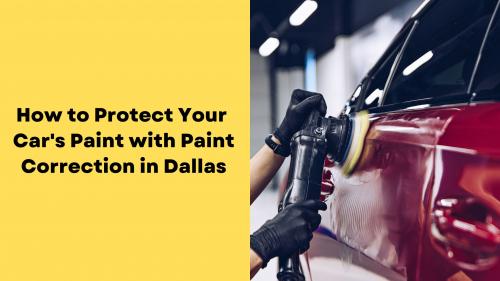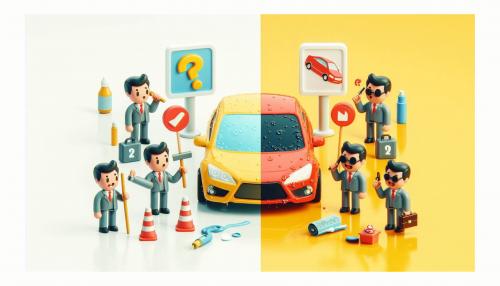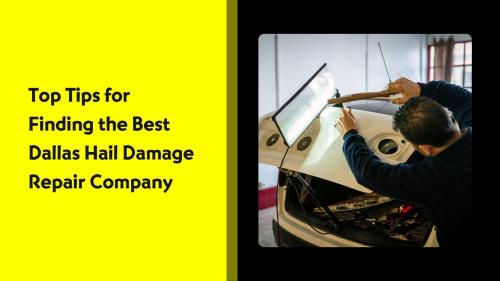How to Protect Your Car's Paint with Paint Correction in Dallas


Your car's paint job is one of its most noticeable features. A shiny, flawless paint finish can make even an older car look great, while a dull, scratched-up paint job can make even the nicest vehicle look worn out. If your car's paint has lost its lustre due to swirling, scratching, oxidation, and other imperfections, paint correction is the solution.
Paint correction, also known as paint decontamination, is the process of removing swirl marks, scratches, water spots, oxidation, and other blemishes from your car's clear coat. It restores the paint to a showroom-quality shine while protecting it from further damage.
Any car owner in the Dallas area looking to spruce up their ride should consider paint correction.
Here is a step-by-step guide on how to protect your car's paint with paint correction in Dallas:
Evaluate the Condition of the Paint
Before beginning paint correction, assess the overall condition of your car's paint. Check for these common paint flaws:
Swirl marks - These are tiny circular scratches in the clear coat caused by improper washing and drying
Scratches - Linear scratches of varying depths in the clear coat and paint
Water spots - Mineral deposits left behind after water dries on the paint
Oxidation - Chalky, faded areas on the surface due to sun exposure and age
Etching - Surface damage from acid rain, bird droppings and other contaminants
Make a note of the type and severity of defects so you know which paint correction methods to use.
Wash and Dry the Vehicle
Thoroughly wash and dry the vehicle before paint correction. Use a high-lubricity car wash soap and a microfiber mitt to gently clean the paint without adding swirls. Make sure to use separate mitts for the paint and wheels. Completely rinse off all soap residue.
After washing:
Dry the car with microfiber drying towels.
Use a spray detailer as a lubricant to prevent water spotting.
Inspect the paint again once it's clean and dry.
Clay the Paint
Claying removes bonded surface contaminants like industrial fallout, rail dust, and tar that washing alone can't remove. Knead a clay bar until pliable and rub it across the paint using plenty of detail spray as a lubricant. Fold and reshape the clay often to expose clean edges.
Claying prepares the paint for polishing by getting rid of debris that could scratch the clear coat during the correction process.
Apply Paint Protection Film
If your vehicle lacks factory paint protection, consider applying paint protection film before paint correction. This thermoplastic urethane film coats the paint with an invisible barrier against rock chips, bug acids, road debris, and other hazards.
Paint protection film needs to go on perfectly clean paint, so clay and correct the paint if required prior to application. Hire a professional shop to apply the film for optimal results.
Machine Polish the Paint
Machine polishing with a dual-action polisher is the best way to thoroughly correct paint.
A DA polisher rotates and oscillates to safely remove swirls, oxidation, etchings, and very fine scratches from the clear coat. Always follow these steps when polishing:
Use polishing pads appropriate for your vehicle's paint type
Work in small sections using the proper polishes and compounds
Keep the polisher moving constantly at the right speeds
Apply light pressure and make several passes to correct defects
Frequently clean pads and change them as they get saturated
Wipe away polish residue between passes
With practice, you'll learn the polishing motions and pressure needed to fix defects. Replace worn pads often for best results.
Polish by Hand (If Needed)
For areas a polisher can't reach, like along edges and body lines, polish by hand using a foam applicator pad. Apply a small amount of polish and work it into the paint using back-and-forth motions. Remove residue with a microfiber towel.
Switch polishes and make multiple passes to remove deeper imperfections. While more thorough than machine polishing, hand polishing can still notably improve the paint.
Apply Paint Sealant
After correction, apply a paint sealant to protect the finish. Paint sealants bond to the clear coat to create a hydrophobic barrier against contaminants. They help lock in clarity and reflectivity while allowing you to clean and polish the paint more easily in the future.
Follow the product instructions to apply the sealant evenly across all painted surfaces. Use a foam applicator, soft microfiber, or foam polishing pad to apply. Buff off any residue after the sealant cures. Reapply every 3-6 months.
Consider a Ceramic Coating
For maximum paint protection, consider having a professional ceramic coating applied. Ceramic coatings form a durable glass-like layer across the clear coat that prevents etching, oxidation, and almost all chemical damage.
The coating makes maintaining the paint's correction much simpler, as contaminants barely adhere to the slick ceramic surface. While expensive, a quality ceramic coating will keep your car looking freshly detailed for years.
Maintain the Finish
To maintain your car's newly corrected and protected paint:
Rinse off debris after every drive once the car cools. Wash weekly or biweekly.
Use a pressure washer to foam the car, and then rinse. Avoid direct pressure washing.
Wash with a premium car wash soap using the two-bucket method.
Dry the vehicle with microfiber towels immediately after rinsing.
Wax or apply a spray sealant every 1-2 months.
Store the vehicle indoors or under a car cover whenever possible.
Apply a fresh coat of paint protection film every 5-10 years.
Proper maintenance will preserve your car's show-quality shine in between professional paint corrections.
Benefits of Paint Correction
Getting regular paint correction for your car provides many advantages beyond aesthetic appeal, including:
Restores gloss, depth, and colour vibrancy
Removes unsightly swirls, scratches and blemishes
Repairs oxidation and chemical damage to the clear coat
Deters future contaminant bonding and etching
Allows waxes and sealants to adhere better and strengthen paint protection
Increases resale value by improving visible paint quality
Keep your car looking like new with professional paint correction in Dallas. Revitalise and protect your paint finish to maintain that straight-from-the-showroom wow factor.
When to Get Professional Paint Correction
While you can perform basic paint correction yourself, it's best to have extensive paint repair done professionally. Hire a skilled auto detailer if your car's paint has:
Severe swirling or deep scratches across large areas
Heavy oxidation, clouding, or fading
Numerous water spots and itching
Large paint chips, clear coat damage, or peeling
Professional detailers have the expertise, tools, and facilities to correct even very worn or damaged paint properly. They can repair issues beyond what you can achieve on your own.
Most detail shops recommend paint correction every 2-3 years to keep cars looking their best. Schedule professional corrections around major milestones like selling or buying a car. It's an affordable way to restore and protect the paint for optimal appeal and value.
Name: Dentwerks Pro
Address: 2605 Andjon Drive, Dallas, TX 75220, United States
Phone No: 972-284-1885





Comments